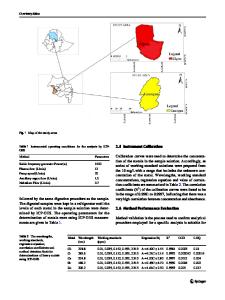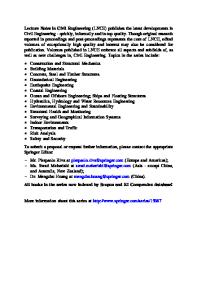Assessment of heavy metal contamination and human health risk with oxidative stress in fish ( Cyprinus carpio ) from Sha
- PDF / 960,009 Bytes
- 10 Pages / 595.276 x 790.866 pts Page_size
- 17 Downloads / 457 Views
ORIGINAL PAPER
Assessment of heavy metal contamination and human health risk with oxidative stress in fish (Cyprinus carpio) from Shahpur Dam, Fateh Jang, Pakistan Asma Khalil 1,2 & Asma Jamil 1 & Tahseenullah Khan 1 Received: 25 July 2019 / Accepted: 2 September 2020 # Saudi Society for Geosciences 2020
Abstract The study was conducted to analyze the water quality of Shahpur Dam, Pakistan, health of native fish Cyprinus carpio, and health risks associated to humans as consumers. Metal (Pb, Cu, Cr, Fe, Ni) concentrations in water and its bioaccumulation in fish tissues (liver, gills, muscles, kidneys, and brain) were determined by using an atomic absorption spectrophotometer. Pb was abundantly found in water (8.15 mg L−1) and fish organs compared with other metals, beyond the permissible referred guidelines. Metal pollution index (MPI) was found high in fish liver followed by gill, muscle, kidney, and brain. Toxicity potential of water pollution was determined in the form of oxidative stress by analyzing catalase (CAT), glutathione S-transferase (GST), and reduced glutathione (GSH) activities in liver and gill of Cyprinus carpio, using UV spectrophotometer. The CAT activity was found higher with inhibition of 41.1% and 2.1% in liver and gill of exposed fish. Inhibition of GST in liver and gill was recorded as 29.4% and 28.1%, respectively, whereas that of the GSH was observed 12.8% and 13.9%, respectively, showing significant oxidative stress in exposed fish of the dam compared with farm fish. Consequently, people consuming the contaminated fish are prone to health impacts, which was estimated by target hazard quotient (THQ), hazard index (HI), and cancer risk (CR). No metal was found to pose potential noncarcinogenic health risk individually or collectively at present but people consuming contaminated fish regularly were expected to be at target cancer risk in 70 years or more of their lifetime. Keywords Bioaccumulation . Bioindicator . Heavy metals . Human health risk . Oxidative stress
Introduction Water resources are the basic driving force behind socioeconomic development of any country. In Pakistan, the issue of water pollution is aggravating due to lack of technology, resources, and awareness among masses. Other factors to add on include high population growth, rapid urbanization and industrialization, unsustainable agriculture practices, and dwindling economic conditions (Gupta et al. 2009; Ahmed et al. 2015; Javed et al. 2016). Water is a vital support for Responsible Editor: Haroun Chenchouni * Asma Jamil [email protected]; [email protected] 1
Department of Earth & Environmental Sciences, Bahria University, Islamabad, Pakistan
2
Project Management and Policy Implementation Unit (PMPIU), Ministry of Water Resources, Islamabad, Pakistan
aquatic life to thrive in but, when the water pollutants (metals and pesticides) accumulate in the body of aquatic biota, it poses negative health impacts on them, with due course of time. Among aquatic biota, fish is most widely consumed as food and i
Data Loading...











